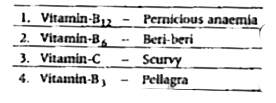Which one of the following pairsof items correctly belongs to the caterogy of organs mentioned against it?
Necitiating membrane and blind spot in human eye - Vestigial organs
Nephridia of Earth worm and Malphighian tubules of Cockroach - Excretory organs
Wings of Honey bee and wings of Crow - Homologous organs
Thorn of Bogainvillea an tendrils of Cucurbita -Analogous organs
The correct Answer is:B
Step by step video, text & image solution for Which one of the following pairsof items correctly belongs to the caterogy of organs mentioned against it? by Biology experts to help you in doubts & scoring excellent marks in Class 12 exams.
Topper's Solved these Questions
Similar Questions
Knowledge Check
- Question 1 - Select One
Which one of the following pairs of items correctly belongs to the category of organs mentioned against it
ANephridia of earthworm and Malpighian tubules of Cockroach- Excretory organsBWings of honey bee and wings of crow- Homologous organsCThorn of Bougainvillea and tendrils of Cucurbita- Analogous organsDNictitating membrane and blind spot in human eye- Vestigial organs - Question 2 - Select One
Which one of the following pairs of item correctly belong to the category of organs mentioned against it ?
Anephridia of earthworm and malpighian tubules of cockroach -excretory organsBwings of honey bee and wings of crow-homologous organs.Cthorns of Bougainvilea and tendrils of Cucurbita -analogous organsDnictitating membrane and blind spot in human eye -vestigial organs. - Question 3 - Select One
Which one of the following is not correctly matched ?
 ANeoprene: ⎡⎢ ⎢⎣−C∣ClH2C=CHCH2−⎤⎥ ⎥⎦nBNylon-6, 6: ⎡⎢ ⎢⎣−NH(CH2)6NHO∣∣C(CH2)4O∣∣C−⎤⎥ ⎥⎦nC
ANeoprene: ⎡⎢ ⎢⎣−C∣ClH2C=CHCH2−⎤⎥ ⎥⎦nBNylon-6, 6: ⎡⎢ ⎢⎣−NH(CH2)6NHO∣∣C(CH2)4O∣∣C−⎤⎥ ⎥⎦nC DPMMA : ⎡⎢ ⎢ ⎢ ⎢ ⎢ ⎢ ⎢ ⎢ ⎢⎣−CH2−CH3∣C∣COCH3∣∣O−⎤⎥ ⎥ ⎥ ⎥ ⎥ ⎥ ⎥ ⎥ ⎥⎦n
DPMMA : ⎡⎢ ⎢ ⎢ ⎢ ⎢ ⎢ ⎢ ⎢ ⎢⎣−CH2−CH3∣C∣COCH3∣∣O−⎤⎥ ⎥ ⎥ ⎥ ⎥ ⎥ ⎥ ⎥ ⎥⎦n
Which one of the following is not correctly matched?
View SolutionWhich one of the following is not correctly matched?
View SolutionWhich one of the following is correctly matched ?
View SolutionWhich one of the following is correctly matched ?
View SolutionWhich one of the following is correctly paired?
View Solution


